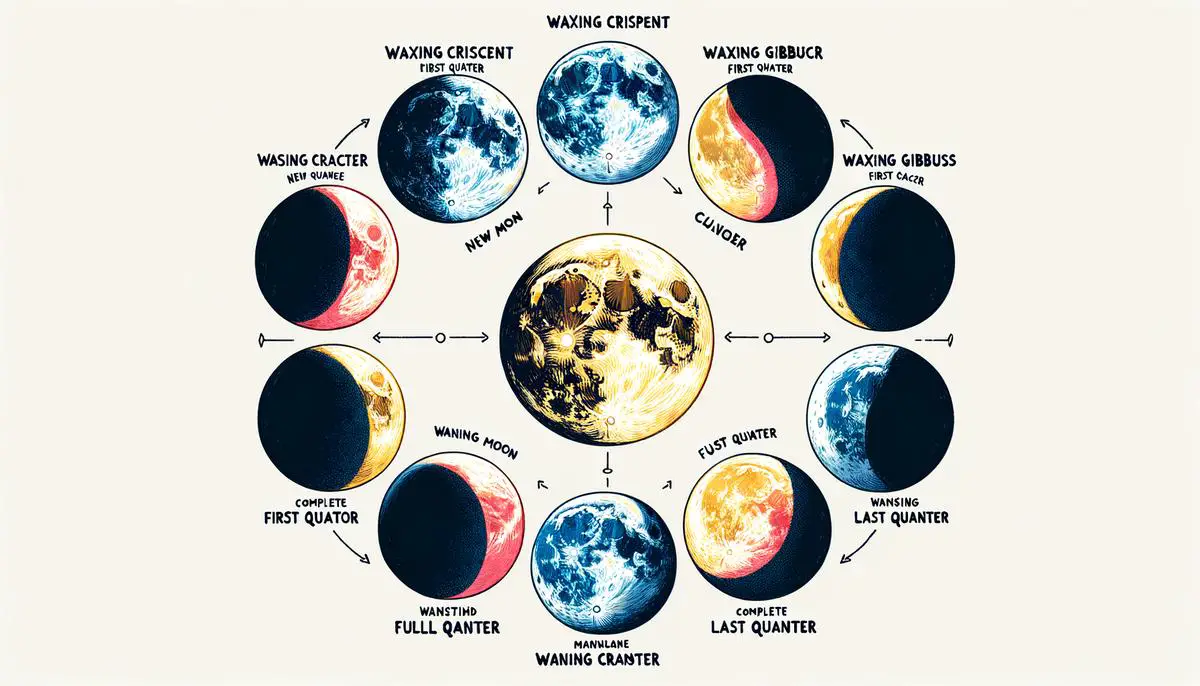The moon, a celestial body that has captivated humanity’s attention for millennia, plays a pivotal role in our lives beyond just lighting up the night sky. Its phases bring a rhythm to the world around us, influencing various activities that range from agricultural practices to personal growth endeavors. This article explores the intricate relationship between moon phases and human activities, particularly focusing on moon beaming—a practice that seeks to harness the unique energies of each lunar phase. By understanding this celestial cycle, we can align our actions with the natural flow of energy in the universe, enhancing both our personal and collective experiences.
Understanding Moon Phases
Moon phases have fascinated humans throughout history, guiding everything from sea navigation to planting of crops. Among these influences, moon beaming activities, or the practice of harnessing the moon’s energy during different phases, hold a special place. Understanding how these phases influence moon beaming activities requires a step into the celestial dance between the Earth, its satellite, and the sun.
Firstly, let’s look at the fundamental architecture of moon phases. It all begins with the New Moon, a phase where the moon is positioned between Earth and the sun, making it virtually invisible to observers on Earth. This phase signifies new beginnings and is often considered the ideal time to set intentions or start new projects.
As the moon moves in its orbit, it waxes (grows) into a Crescent Moon, where a sliver becomes visible. This phase symbolizes growth and creativity, making it a conducive time for brainstorming or conceptualizing new ideas.
The moon’s journey continues to the First Quarter, where half of it is illuminated. This phase symbolizes decision-making and taking action. It’s during this time that efforts should be doubled for pushing projects forward or overcoming obstacles.
Reaching the Full Moon, the only phase where the moon is entirely illuminated by the sun, marks a period of fruition and realization. It’s a powerful time for reflection, completion of tasks, and reaping the benefits of the energy invested during the earlier phases. Moon beaming activities during this phase often involve charging objects with lunar energy or performing full moon rituals.
After peaking with the Full Moon, the moon wanes (shrinks) back to the Last Quarter. Resembling the First Quarter but on the opposite side, this phase calls for releasing and letting go. It’s a period for breaking bad habits, concluding unwanted tasks, and preparing for a renewal that starts with the next New Moon.
The cycle concludes with a return to the New Moon, starting anew. Emailing these cyclical patterns enables individuals to plan and execute their activities in harmony with lunar energies. By understanding and integrating the characteristics of each phase into moon beaming practices, one can potentially enhance their effectiveness, whether it’s for personal growth, creative endeavors, or reflection and release.
In essence, the phases of the moon provide a rhythm to moon beaming activities, facilitating a natural flow of setting intentions, executing plans, and reflecting on accomplishments. Leveraging these phases allows individuals to synchronize their actions with cosmic timing, offering a unique blend of celestial guidance and earthly endeavor.

Identifying Optimal Viewing Conditions
To enhance moon beaming experiences, understanding the atmospheric and geographical conditions that optimize visibility and intensity of the moon’s glow is crucial. The aim is to find the perfect setting where the moon’s light is not just seen but felt, creating a profound impact on moon beaming activities.
Atmospheric Clarity
is paramount. Clear, unpolluted skies allow the moon’s light to shine at its strongest. Urban areas, with their light pollution and smog, diminish the moon’s brilliance and obscure its details. For the cleanest view, seek out remote locations far from city lights. After rainstorms, the atmosphere tends to be clearer, as the rain helps to remove dust and pollutants from the air, making it an ideal time for moon beaming.Elevation Matters
. Being at a higher altitude puts you closer to the moon and above some of the atmospheric interference experienced at ground level. Mountains, high hills, or even the upper floors of buildings can provide an elevated platform for enhanced moon beaming experiences. The thinner air at higher elevations means less scattering of moonlight, resulting in a more intense lunar glow.Optimal Geographical Locations
include areas with open landscapes—deserts, plains, and coasts offer unobstructed views of the horizon, allowing observers to see the moon from the moment it rises. Water bodies, like lakes or oceans, present a dual experience: not only do you witness the moon in the sky, but its reflection over the water multiplies the moonlight, enriching moon beaming practices.Seasonal Considerations
play a subtle but significant role. During the winter, in many places, the air is generally drier and clearer than in summer, enhancing lunar visibility. Additionally, in regions far from the equator, the angle of the moon’s path through the sky during winter provides a longer and often more dramatic trajectory, offering extended periods for moon beaming.Time It Right
. The moon’s brightness and position change throughout the night. Moonrise and moonset, just like sunrise and sunset, can present especially magical moments for moon beaming. During these times, the moon often appears larger due to an optical illusion when it’s close to the horizon, and its color can vary, adding to its mystical allure.Incorporating these atmospheric and geographical considerations can significantly enhance the moon beaming experience. By understanding and aligning activities with these conditions, one can deepen their connection to the lunar cycle and harness its energy more effectively. The perfect balance of clear skies, strategic elevation, optimal locations, seasonal timing, and precise moments can transform an ordinary moon gazing session into a profound moon beaming ritual, deepening one’s connection with the cosmos.

Techniques for Moon Beaming
Now, embracing the essence of effective moon beaming takes more than just understanding the phases—it’s about the intentional connection we establish with the lunar energies. Here, we dive into distinct practices to enhance that bond, beginning with setting sacred spaces, followed by visualization techniques, then sealing the experience with homemade moon water, and finally how to record our moon beaming journey.
1. Setting Sacred Spaces:
To initiate moon beaming, it’s paramount to curate a physical space that resonates with tranquility and intention. This need not be elaborate; a quiet corner in your home where you feel at peace will serve perfectly. Within this space, arrange items that symbolize your connection to the moon—a white candle for purity, a silver adornment symbolizing lunar energy, and crystals like moonstone or selenite to amplify lunar connections. As you arrange these items, focus your intent on opening a pathway to lunar energies and invite them into your space.
2. Visualization Techniques:
With the sacred space set, transition to visualization. Sit or stand comfortably, close your eyes, and breathe deeply to center yourself. Imagine the moon’s glow enveloping you in a serene, silver light. Picture this light as a conduit, directly linking you with the lunar essence. Visualize your goals, dreams, or what you seek to release aligning with this light. The more vividly you can paint this internal picture, the stronger your connection will be. This helps to anchor your intentions in the cosmic web facilitated by the moon’s energy.
3. Crafting Moon Water:
Moon water harnesses the symbolic power of the moon and serves as a tangible reminder of your intentions. To prepare it, fill a clear container with water and leave it overnight under the moonlight—preferably outside or on a windowsill facing the moon. You may add clear quartz to enhance purification or rose quartz for love-related intentions. The following morning, retrieve your moon water; it’s now charged with the vibrational essence of the lunar cycle you’re working with. Use this water for drinking, in baths, or to sprinkle around your sacred space.
4. Recording the Journey:
For full integration, documenting each moon beaming experience is crucial. Maintain a journal dedicated to these practices. After each session, jot down feelings, visions, or specific outcomes you desire. Note any shifts in your energy or life as you progress. Over time, this journal becomes a roadmap of your spiritual evolution, guided by the lunar cycles.
In performing these steps routinely, alignment with lunar energies isn’t just theoretical—it becomes a lived reality. Each phase of the moon brings specific energies, and by engaging comprehensively through creating sacred spaces, visualization, moon water crafting, and reflective journaling, we attune more deeply to these cycles, unfolding a rich tapestry of spiritual connection and personal growth.

As we explore and engage with the lunar cycles through practices like setting sacred spaces, visualization techniques, crafting moon water, and reflective journaling, we open ourselves up to a deeper connection with the cosmos. This alignment not only enriches our spiritual lives but also offers practical benefits in daily living by attuning us to natural rhythms. The journey through each moon phase brings its own set of energies and opportunities for growth—inviting us to live more harmoniously within ourselves and with the world around us. Thus, embracing these practices is not merely about observing celestial phenomena but about integrating them into our lives as tools for transformation and enlightenment.
![]()

I’ve been surfing online more than 2 hours today, yet I never found any interesting
article like yours. It is pretty worth enough for me.
Personally, if all webmasters and bloggers made good content as you did,
the internet will be a lot more useful than ever before.